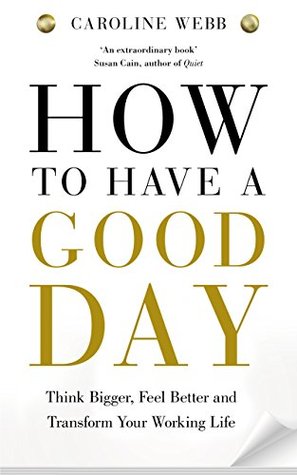More on this book
Community
Kindle Notes & Highlights
Read between
July 3 - December 4, 2019
to help make my intentions a reality? Specifically: What does that shift look like in practice—and what actions will I take today?
priority had been to help the new team gel,
positive intention
two specific behavioral goals to support it.
said something to appreciate each person’s contributions at some poin...
This highlight has been truncated due to consecutive passage length restrictions.
point out whenever someone’s ideas nicely connected to something another pers...
This highlight has been truncated due to consecutive passage length restrictions.
don’t just set yourself task completion goals. Set at least one or two goals for your own behavior, and make them as specific as you possibly can, to magnify your chances of having the day you intended.
FIND A WINNING ARTICULATION OF YOUR GOALS
describe them in a way that is positive, personally meaningful, feasible, and situation-specific.
doing more of something good,
“approach” goals)
Ask yourself: “What positive outcome am I seeking? And what do I need to start doing, or do more of, to get that ideal outcome?” If any of your goals are about avoiding something, turn them around and ask what good thing you’d need to do more of to achieve the same outcome.
we’re more likely to achieve a challenging goal if we’ve decided for ourselves why it’s worth succeeding. Or to use psychological terminology: intrinsic motivation—where we’re doing things because they feel personally meaningful or satisfying—
Requests from other people activate brain areas strongly associated with self-control and self-discipline; by contrast, goals we set for ourselves engage areas associated with our desires and needs.
think about why it matters to us personally.
“What bigger aspiration or value of mine does this task speak to?” “How does this request support something that matters to me?”
break your big audacious goals into a series of small step-by-step goals that are within your reach.
lists the projects I’m working on, and for each one I’ve identified the very next thing to do on each of them.
“when-then” rule, which says, “when X happens, then I will do Y.”
having a process for capturing to-dos as soon as they occur to you, even if you then end up transferring them to a master list.
Only keep today’s tasks in view.
Make it satisfying to check off.
Be realistic about what you can do in a day.
Put exercise, rest, and other physical health goals on your list alongside your other tasks.
Set some behavioral goals. Personally, what behavior of yours will support your intentions for the day? Specifically, what tangible actions can you plan to take?
Create “approach” goals. Make sure your goals are about doing desirable things, or doing more of them, rather than avoiding bad things happening.
Find a personal why. Can you articulate why the goal matters to you or how it will benefit something you care about?
Break off bite-sized chunks.
Make a “when-then” plan. Define clear situational prompts (“when X happens, then I will do Y”) to increase the chances that you’ll get your most important goals met today.
“mental contrasting,” because you’re comparing your ideal outcome with the pesky reality of day-to-day life.
the obstacles they’re facing, and plan for both.
What’s most likely to get in the way of you succeeding in meeting your goals for today? What’s your “when-then” contingency plan to prevent that obstacle from getting in the way?
spreading activation effect.
small cues can push our thoughts, feelings, and actions in one direction or another.
think back to your intentions, and consider the kinds of thoughts and feelings you want to encourage in yourself today. Ask yourself: Which words or phrases might help remind you of those intentions? • Try writing a “note to self” that prompts you to keep this language in mind today. • Consider using that language on your to-do list, or in your meetings and emails.
Can you make your surroundings a metaphor for your intentions?
open-mindedness, consider finding an open space to sit and think.
creativity, you might try to sit in a place that’s full of art
relaxed discussion, choose a cozy space rather than a boardroom. • Need to think particularly clearly today? Clear your desktop or workspace. Brighten the lighting.
MIND’S-EYE REHEARSAL
visualizing something
rehearse a particular behavior,
imagine how I want the session to go.
previous difficult presentation that went well, and I remember how I handled it. I take a deep breath, and I think about each aspect of that successful memory and also the physical sensation of that past experience.
takes advantage of as much sensory information as possible: visual images, yes, but also sounds, feelings, smells, even tastes.
Relive past glories.
Rehearse today’s challenge.
“In the evening, I always think about the two or three things that really need to happen tomorrow,”
think about what I want to achieve with the day, what I need to bring to the meetings I’m having.
visualizing who I want to ‘be’ in front of the people I’m meeting—what I want to project in how I behave—as well as how I’m going ...
This highlight has been truncated due to consecutive passage length restrictions.


